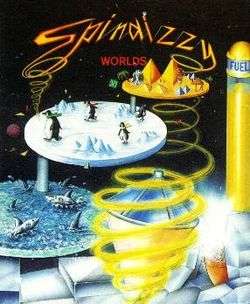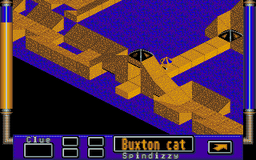Spindizzy Worlds
| Spindizzy Worlds | |
|---|---|
 | |
| Publisher(s) |
Activision, ASCII Entertainment (SNES) |
| Platform(s) | Amiga, Atari ST, SNES, Sharp X68000, NEC PC-9801 |
| Release date(s) | |
| Genre(s) | Puzzle |
| Mode(s) | Single-player |
Spindizzy Worlds is a puzzle video game published by Activision, released on the Amiga and Atari ST in 1990. It was later released on the Super Famicom in 1992 and the Super Nintendo Entertainment System in 1993 by Ascii Entertainment and on the Sharp X68000 and the NEC PC-9801 in 1992 by Arsys Software as Spindizzy II. The game is a sequel to the 1986 video game Spindizzy. Like its predecessor it uses an isometric view, and the player controls a spinning top kind of robotic device named GERALD, a Geographical Environmental Reconnaissance And LandMapping Device, that is tasked with exploring and mapping a star system before it is destroyed.
Gameplay

GERALD has limited controls only being able to move around with the use of braking and accelerating, there is no jumping, attacking or other actions. The player must guide the device through several levels, there are many hazards enemies and puzzles based on finding and pressing switches in the correct order, navigating thin pathways without falling off, finding all gems dotted about a section. GERALD cannot jump on its own but can reach higher platforms and traverse large gaps by accelerating and jumping over slopes or ramps, or using moving platforms, warps or platforms that make it bounce. GERALD's health, called fuel, is full at the beginning of each level and it depletes slowly over time especially with quick movements. Falling from a height onto a surface, falling off the bottom of a stage, or contact with enemies and hazards also takes away health too, but it is replenished in small amounts after finishing a section of a stage and by collecting gems that are found around most levels. Some levels contain enemies, but they only hinder the players progress and do not have to be defeated to progress and can be avoided. The stages can be viewed from four different camera views at 90° angle rotation from each other, the player has manual control over the camera view; views of objects and paths may be obscured behind other platforms in some views, and easier seen in others.
To start, the level select screen has two clusters or, star systems Easy and Hard, named Easydizzy and Spindizzy in the SNES version. The harder system contains more complex level and a higher number of levels than the easier system. In both clusters planets represent levels, and although the player has a choice of which to level to play, the easier outer planets must be completed before the harder inner planets can be selected. The central star is the final stage and can only be selected after all the others are beaten. The levels are all individually named and may have a distinct visual or gameplay style. In the SNES version, once a level has been completed, the planet will explode and the level cannot be revisited; the player is then given a password.
The game was ranked the 13th best game of all time by Amiga Power.[1]
References
- ↑ Amiga Power magazine issue 0, Future Publishing, May 1991